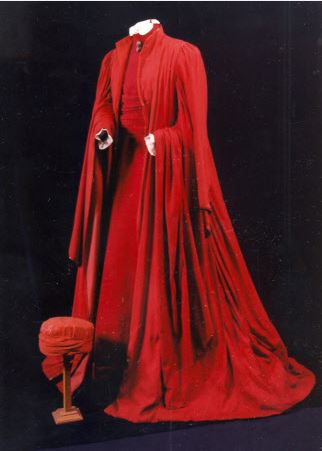This blog continues in the “Europe & the U.S. in 99 Objects” series. Dr. Gabriella de la Rosa at the National Trust has started this project for the National Trust, originally published here, by delving into the Trust’s collections – nearly 1 million objects held at over 200 historic properties across the United Kingdom – to find objects with interesting, unusual and unexpected connections to Europe. These objects and their stories are being published in the form of a digital diary on the National Trust Collections website.
#22 Costume for ‘Portia’ in ‘The Merchant of Venice’
Auguste & Co
Category: Costume
Date: circa 1883 – 1887
Materials: Cotton, Metal, Silk
Place of origin: Great Britain
Collection: Smallhythe Place, Kent (Accredited Museum)
On show at: Not on show
NT 1118837.2
In Act IV of ‘The Merchant of Venice’, Portia masquerades as a doctor of laws in order to outwit the vilified Shylock. To succeed, she must not only feign legal expertise; she must cross-dress in men’s judicial robes in order to exercise powers otherwise denied to her because of her sex. The great Shakespearean actress Dame Ellen Terry (1847-1928) earned the highest accolades of her career playing the role of Portia, first in 1875 at the Prince of Wales’s Theatre and then in 1879 at the Lyceum Theatre. It was for the Lyceum production that she donned the stunning red costume seen here to perform this pivotal scene. While it isn’t known if Shakespeare ever set foot in Italy, it certainly held a special place in his imagination. Venice – that prosperous maritime centre where different nations and peoples intermingled in ways not possible in England – is the backdrop against which Portia can engage in transvestism, and as a result, adjust gender imbalances of the time. This costume is connected to another famous cross-dresser, Vita Sackville-West. She wore it at a Fancy Dress Ball at Knole in 1910 in aid of the Shakespeare Memorial Theatre Fund, where Ellen Terry also performed. Vita later wrote of the actress: ‘She was all woman to me’.
Smallhythe Place © National Trust / Andrew Fetherston
Summary: Dress of ribbed red silk, with plain cotton ‘puritan’ collar, and two decorative metallic buttons. Part of costume worn by Ellen Terry (1847-1928) in the role of Portia in ‘The Merchant of Venice’ at the Lyceum Theatre in 1879. Comprising a robe (TC/112a), dress (112b), sash (112c), and cap (112d). See also a coloured photo-lithograph of Ellen Terry wearing the costume (NT 1118338) and Clare Atwood’s imaginary portrait of Vita Sackville-West wearing the costume lent to her by Terry for the Fancy Dress Ball at Knole on 3 July 1910 (NT 1118225).
#23 Emperor Probus, Emperor of Rome (232-282 AD)
The Vyne © National Trust Images / James Mortimer
Category: Art / Sculpture
Date: Unknown
Materials: Terracotta
Collection: Vyne Estate, Hampshire (Accredited Museum)
On show at: The Vyne, Hampshire, London and South East, National Trust
NT 719614
Britain is well known for its gardens, but not so much for its winemaking. Nevertheless this terracotta roundel, on display at The Vyne in Hampshire, speaks to our viticultural connections to ancient Rome. The exquisitely carved figure at the centre of the roundel is the man who introduced vines to Britain: Marcus Aurelius Probus, Emperor of the Roman Empire (AD 276 – 282). Probus is said to have grown weary of war and encouraged his legionnaires to engage in peaceful reconstructive work, specifically the extensive planting of grapevines throughout Europe. Unfortunately for Probus, his oenophilic ambitions were not reciprocated by his troops who favoured the glory of battle over the arduous graft of vine cultivation. The emperor met his end on a nascent vineyard in Sirmium (present day Serbia) when a group of his soldiers-cum-farmers chased him into a tower and killed him. This roundel was probably made in the Florentine workshop of Giovanni da Maiano in the 1520s and is one of the earliest examples of Italian Renaissance sculpture in this country. According to tradition, the first grapevines introduced to Britain were planted near The Vyne, giving the house its name and making this roundel an especially fitting sculptural addition.
Summary: Terracotta, Emperor Probus, Emperor of Rome (232-282 AD). Medallion bust of the Roman Emperor Probus, who authorised the introduction of vines into Britain. It resembles those busts of Emperors made by Giovanni di Maiano for Hampton Court in 1521 and may have been inserted by William Sandys.
Provenance: Not in 1754 inventory; may have been acquired after the Tudor ‘Holbein’ gate in Whitehall was demolished in 1759-60; bequeathed with The Vyne, estate and contents by Sir Charles Chute, 1st Bt (1879-1956)




